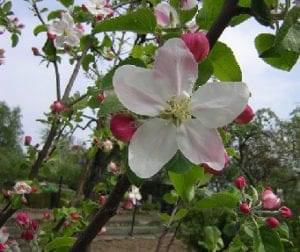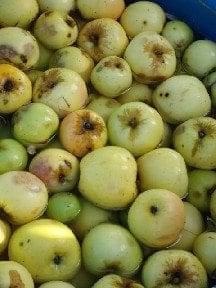
Malus domestica/sylvestrus
a.k.a.: Fruit of the Gods, Fruit of the Underworld, The Silver Bough
Although apple is familiar as food in our kitchens, an herbalist has to return to the old almanacs for reminders of its medicinal properties. It’s surprising that these simple and reliable remedies have fallen out of use since apple is so prevalent in our homes and backyards.
Apple’s Medicinal Properties
Apple is highly nutritive with a healing balance of minerals, protein, fiber and vitamins A and C. The apple fiber famous for absorbing water is called pectin. Although pectin is available in other fruits, apples have highly condensed amounts of it. Pectin works in the body as a valuable stool softener to ease constipation and a quick remedy for diarrhea. Pectin is an excellent remedy for quickly removing toxins and heavy metals from the body. It binds and eliminates these poisons from fat within the tissue.
Pectin is also used commercially in surgical bandages. Its powerful wound healing properties along with its astringent qualities have been used to to treat cuts on delicate tissue. A cold slice of apple does wonders for in tender wounds like a split lip.
The soothing actions of applesauce lend themselves to treating stomach aches. Apple’s pectin is easier to access in applesauce form. Applesauce is also a key ingredient in facial packs for oily skin. Since applesauce is both astringent and binding, it not only opens the pores but it also softens the skin.
Apple cider vinegar has its own loyal following. Many people take a spoonful of apple cider vinegar every day to balance the pH in the body. People with allergies can sip a teaspoon of apple cider vinegar in the morning to revitalize their immune system by keeping the stomach acid in check. This balance is the key to staving off and treating a host of complaints.
Apple cider vinegar is the base for one form of herbal medicine. Instead of using an alcohol and water mixture as a medium for extracting medicinal qualities of herbs, try vinegar. It’s more cost effective, child safe and appropriate for those with sensitivities to alcohol.
Conditions Helped by Apple
Both diarrhea and constipation are greatly helped by Apple’s abundance of pectin. This is best served as applesauce so the fiber is softened and more easily digested.
Wounds to delicate tissues, such as the lip, are greatly helped by apple’s astringent properties. Apply a raw slice of apple to any wound for quick relief. Some areas swell up instantly when an area is wounded. These are excellent spots for fresh apple applications.
Apple cider vinegar is excellent for allergy prevention. It stabilizes the body’s pH to allow the system a chance to gird its own defenses. Many allergy sufferers take a daily spoonful of apple cider vinegar as part of their morning routine.
Although it seems counter-intuitive, apple cider vinegar also serves as ulcer prevention medicine. Those with a propensity towards this reoccurring problem can take regular doses of apple cider vinegar to guard against an attack. For some, just a spoonful stirred into a glass of water 2 or 3 times a day is enough to keep the body safe.
List of Apple’s Actions
Astringent, nutritive, and digestive.
Gardening and Growing Apples
Apple is from the
Rosaceae family. Apples grow on small, rounded trees with oval, alternate and deeply veined leaves. Each leaf is finely toothed along its edges. The flowers are white with pinkish blushes that develop into lovely round fruit from September to November. The fruit dazzles the eye with its earnest display of color. There are literally thousands of varieties of apples ranging from pale yellow to tart green to fire engine red. Variation continues with texture and taste, but if you cut any of these varieties open width wise, the core reveals seeds nestled in a star pattern.
It takes about six to ten years for an apple tree to bear its first fruits; being a softwood tree, its growth is fairly rapid. A fully-mature tree will blossom in early spring and the resulting apples will be ready for harvest within three to six months, depending on the variety.
Different apple species ripen at different times of year. The trees with the earliest harvest dates develop blossoms before honey bees are out of hibernation. If you have an early apple tree, consider putting up a Mason bee house to encourage these early pollinators to increase apple production.
Apple trees require regular pruning if you want to keep them healthy and producing lots of fruits each year. Pruning the tallest branch (called the leader branch) will keep apple trees from growing too tall to properly harvest. It is also important to thin apple buds so the tree bears fewer but larger and tastier apples.
Gathering Apples
Apples are very easy to gather. When they are ripe, all it takes is a gentle twist and the fruit comes right off in your hand. Different species ripen into different colors when they are ready to be eaten. Get to know the species you’re harvesting so you know the signs telling you it’s time to get picking.
Apple trees produce annually but they are alternate bearing trees meaning they’ll give a light yield every other year. One way to predict their harvest is to remember that even numbered years (2012, 2014, etc) are years of heavy harvests. It is wise to preserve the apples as best you can during these years by freezing, canning or drying abundant fruit.
Apples are heavy. Gather them in a box or hefty basket. Small harvests can be gathered in a bag. See our kid friendly section for instructions on sewing your own apple gathering bag.
[su_heading size=”5″]Quick ID Tips[/heading]
Malus Species
[su_tabs vertical=”yes”][su_tab title=”Appearance:”]A deciduous tree with alternative, oval green leaves with a downy underside. Branches have twigs and gray scaly bark. The flowers have 5 petals and are white to pinkish white. Fruits have 5 carpels with 3-5 seeds in each carpel. Apple ripens in the fall and can range in size and color according to species.[/tab] [su_tab title=”Taste:”]Apples range in texture (mealy to crisp) and sweetness./tab] [su_tab title=”Odor:”]Flowers have a light floral scent. Apple fruit smell smells tart and sweet (like apples, of course).[/tab][/tabs]
Using Apple to Care for Animals
Apples can be safely consumed by most animals, although horses should not eat a large quantity of them because an excess of apples can cause colic and fodder, particularly in those who are predisposed to these diseases.
Apples can be used externally with ease for small wounds on our animal friends. Critters with damage to sensitive tissues such as the tongue or lips benefit quickly from a slice of apple applied to the wound.
Apple cider vinegar is a common ingredient in many old-time veterinary first aid kits. Swollen joints are the bane of pet owners with older animals and working farm animals. The old trick of wrapping a swollen joint with a warm rag soaked in apple cider vinegar is still in use for those in the know.
Household and Non-medicinal Uses for Apple
Dried apples make a wonderful snack for mid-winter to early summer eating.
Applesauce is good to keep on the shelf for good eating in sickness and in health.
Apple cider vinegar is a favorite of many folk as a substitute for virtually any recipe that calls for white vinegar. Any one who has extra apple cider can easily turn it to apple cider vinegar. Simple, step-by-step instructions are also on this site.
Apple cider mulled or fermented makes a wonderful mid-winter drink to warm the spirits.
For more recipes and ideas for using apples, see The Practical Herbalist Recipes.
Cautions for Using Apple
Be wary of feeding a lot of animals to horses because an excess of apples can cause colic and fodder, particularly in those who are prone to these diseases.
No known cautions for humans exist for this herb.
For more information see our History, Folklore, Myth and Magic page on Apple.





